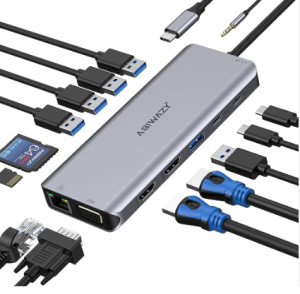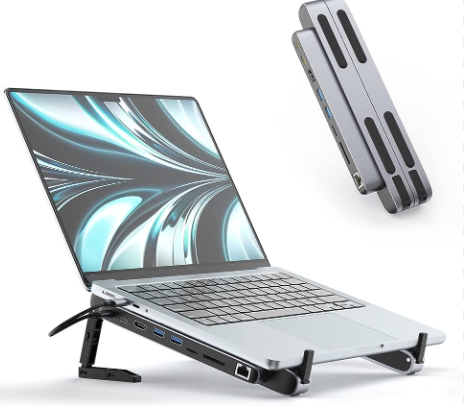Dell Docking Station For Laptop
In the modern world of technology, mobility and versatility are key. Laptops have become an essential tool for professionals and students alike, offering the freedom to work or study from anywhere. However, there are times when the convenience of a laptop screen just isn’t enough. That’s where docking stations come into play, and Dell has established itself as a frontrunner in this domain. In this guide, we’ll delve into the realm of docking stations and explore the best options Dell has to offer.
Why Do You Need a Dell Docking Station?
A docking station is a peripheral device that allows you to expand the capabilities of your laptop. It provides additional ports, such as USB, HDMI, DisplayPort, Ethernet, and more, effectively turning your laptop into a powerhouse workstation. Whether you’re looking to connect multiple monitors, access high-speed internet, or connect various peripherals, a docking station can greatly enhance your productivity and user experience.
Factors to Consider When Choosing a Dell Docking Station
Port Selection: The first and foremost aspect to consider is the port selection. Depending on your needs, you should ensure that the docking station offers the necessary ports. Common ones include USB-A, USB-C, HDMI, DisplayPort, Ethernet, audio jacks, and more.

Compatibility: Not all docking stations are compatible with every laptop model. It’s crucial to check whether the docking station you’re interested in is compatible with your Dell laptop. Dell often provides compatibility information on their website.
Power Delivery: If you want your docking station to charge your laptop while connected, look for Power Delivery (PD) capability. This feature ensures that your laptop remains charged even during resource-intensive tasks.
Number of Monitors Supported: If you’re aiming for a multi-monitor setup, make sure the docking station can support the number of monitors you intend to connect. Some models support up to two external monitors, while more advanced ones can handle even more.
Build Quality and Design: The build quality of the docking station is important for durability. Additionally, the design should allow for efficient cable management and provide a stable platform for your laptop.
Additional Features: Some docking stations come with extra features such as SD card readers, extra USB ports, and audio output options. Evaluate these features based on your specific needs.
Top Dell Docking Stations for Laptops
Dell WD19 Docking Station: The Dell WD19 is a versatile docking station with multiple USB-C and USB-A ports, HDMI, DisplayPort, and Ethernet ports. It supports up to two FHD monitors and offers Power Delivery up to 90W, making it suitable for a wide range of Dell laptops.
Dell D6000 Universal Dock: This docking station is designed for users who require extensive connectivity options. With USB-C and USB-A ports, HDMI, DisplayPort, and even a DisplayLink technology for connecting up to three 4K displays, the D6000 is a powerhouse. It also provides Power Delivery up to 65W.

Dell WD15 Docking Station: The WD15 is a compact docking station with a solid selection of ports, including USB-C, USB-A, HDMI, Mini DisplayPort, and Ethernet. It supports dual monitors and offers Power Delivery up to 130W, ensuring your laptop stays charged.
Dell Thunderbolt Dock TB16: If you’re looking for maximum performance, the Thunderbolt Dock TB16 is a top choice. With Thunderbolt 3 technology, it offers lightning-fast data transfer speeds, supports up to three 4K displays, and provides ample USB, HDMI, DisplayPort, and Ethernet ports.
Dell WD21 Docking Station: The WD21 is a newer addition to Dell’s docking station lineup, offering enhanced connectivity and compatibility. It supports up to three 4K displays and provides a mix of USB-C, USB-A, HDMI, DisplayPort, and Ethernet ports.
A Guide to Choosing the Best Dell Docking Station for Your Laptop
Dell docking stations are essential tools for enhancing productivity and convenience, allowing you to connect your laptop to a variety of peripherals with ease. With various options available, selecting the right Dell docking station for your laptop can be a critical decision. Here’s a comprehensive guide to help you make an informed choice:
Compatibility:
Ensure the docking station is compatible with your laptop’s model and operating system. Dell offers universal and model-specific docking stations, so check the compatibility list before purchasing.
Ports and Connectivity:
Consider the types and number of ports you need for your setup. Common ports include USB-C, USB-A, HDMI, DisplayPort, Ethernet, audio jacks, and more. Choose a docking station that offers the right combination of ports to accommodate your peripherals and monitors.
Display Support:
If you require multiple monitors, ensure the docking station supports the desired number of displays and their resolutions. Some docking stations can handle dual 4K displays, while others might support a single 4K or multiple Full HD monitors.
Power Delivery:
If you want to charge your laptop while it’s connected to the docking station, ensure the docking station supports power delivery (PD) through USB-C. This feature can help streamline your workspace by reducing the number of cables you need.
Performance and Data Transfer:
For tasks like video editing or transferring large files, opt for a docking station with high data transfer rates. Look for USB 3.1 or Thunderbolt options for faster data transfer speeds.
Audio and Mic Support:
If you frequently use audio peripherals like headphones or microphones, choose a docking station with reliable audio input/output capabilities.
Build Quality and Design:
Consider the build quality of the docking station. A well-built docking station with sturdy connectors will ensure a reliable connection and longevity. Also, choose a design that complements your workspace setup.
Ease of Use:
Look for docking stations that offer plug-and-play functionality. An easy setup process will save you time and frustration.
Brand Reputation and Reviews:
Check user reviews and testimonials to get an idea of real-world experiences with the docking station you’re considering. Dell’s reputation for quality can be a good indicator, but it’s always wise to research.
Future-Proofing:
Technology evolves rapidly, so consider choosing a docking station that supports emerging connectivity standards like Thunderbolt 4 or USB4, even if your current laptop doesn’t fully utilize them. This can help future-proof your investment.
Budget:
Set a budget range and explore docking stations within that range. While it’s tempting to go for the most feature-rich option, make sure it aligns with your needs and budget.
Conclusion
In a world where flexibility and productivity are paramount, Dell docking stations stand as essential tools for laptop users. They transform your portable workstation into a versatile hub that accommodates multiple peripherals, monitors, and more. When choosing the best Dell docking station for your laptop, remember to consider factors like port selection, compatibility, power delivery, and additional features. With options like the Dell WD19, D6000, WD15, Thunderbolt Dock TB16, and WD21, Dell caters to a wide range of needs, ensuring that your laptop can adapt to any task or environment. Whether you’re a professional, a student, or anyone in between, a Dell docking station can revolutionize the way you work and play.
FAQs about the Best Dell Docking Station for Laptops
What is a Dell docking station and why do I need one for my laptop?
A Dell docking station is a peripheral device that allows you to connect your laptop to a variety of peripherals and accessories, such as monitors, keyboards, mice, printers, and more. It provides additional ports and connectivity options that your laptop might lack, enhancing productivity and convenience. Docking stations eliminate the need to constantly plug and unplug cables, making it easy to transition your laptop between a mobile and desktop setup.
What features should I consider when choosing the best Dell docking station for my laptop?
When selecting a Dell docking station, consider factors such as the number and type of ports it offers (USB, HDMI, DisplayPort, Ethernet, etc.), its compatibility with your laptop model, maximum resolution and refresh rates supported for external displays, charging capabilities, audio options, and any additional features like built-in card readers or security locks. The docking station’s ability to support multiple monitors and its power delivery capacity are also essential considerations.
Which Dell docking station is recommended for dual monitor setups?
If you’re looking to set up a dual monitor configuration, you should opt for a Dell docking station that supports multiple displays. The Dell D6000 Universal Docking Station is a popular choice for dual monitor setups. It offers support for up to three displays, including two 4K displays or one 5K display, making it suitable for both work and entertainment purposes.
Can I use a Dell docking station with non-Dell laptops?
Yes, in many cases you can use a Dell docking station with laptops from other manufacturers. However, it’s important to check the compatibility of the docking station with your laptop’s specific model and its operating system. While some features may work universally, certain proprietary features might function optimally only when used with Dell laptops.
Are USB-C docking stations better than traditional docking stations for Dell laptops?
USB-C docking stations have gained popularity due to their versatility and higher data transfer speeds compared to traditional docking stations. They often provide power delivery, allowing you to charge your laptop while connected to peripherals. If your Dell laptop has a USB-C or Thunderbolt 3 port, a USB-C docking station like the Dell Thunderbolt Docking Station could offer a seamless experience with faster data transfer rates and enhanced connectivity options. However, compatibility with your laptop’s ports and your specific requirements will determine whether a USB-C or traditional docking station is better for you.
